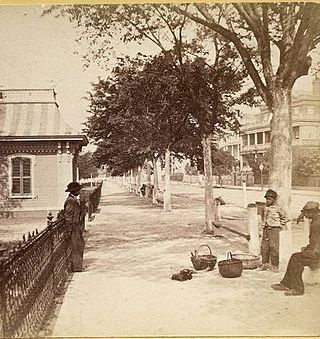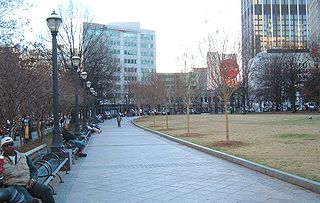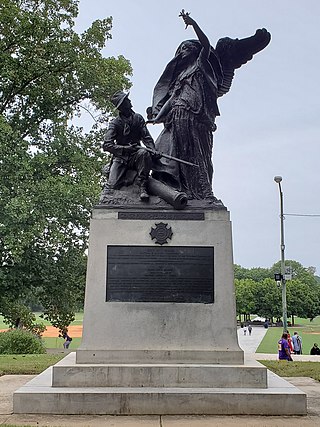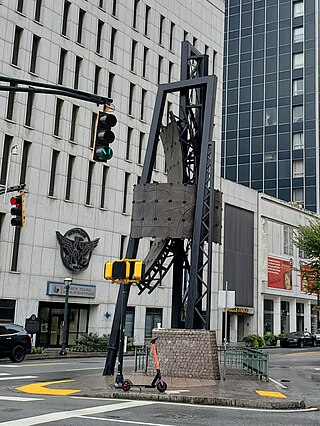Related Research Articles

Morrow is a city in Clayton County, Georgia, United States. It is part of the Atlanta metropolitan area. Its population was 6,445 at the 2010 census, up from 4,882 in 2000. It is the home of Clayton State University and the Georgia Archives.

Dixie Highway was a United States auto trail first planned in 1914 to connect the Midwest with the South. It was part of a system and was expanded from an earlier Miami to Montreal highway. The final system is better understood as a network of connected paved roads, rather than one single highway. It was constructed and expanded from 1915 to 1929.
The Georgia Board of Regents oversees the University System of Georgia as part of the state government of Georgia in the United States. The University System of Georgia is composed of all state public institutions of higher education in the state. The Board of Regents also preside over the Georgia Public Library Service.
East Atlanta is a neighborhood on the east side of Atlanta, Georgia, United States. The name East Atlanta Village primarily refers to the neighborhood's commercial district.


Oakland Cemetery is one of the largest cemetery green spaces in Atlanta, Georgia, U.S. Founded as Atlanta Cemetery in 1850 on six acres (2.4 hectares) of land southeast of the city, it was renamed in 1872 to reflect the large number of oak and magnolia trees growing in the area. By that time, the city had grown and the cemetery had enlarged correspondingly to the current 48 acres (190,000 m2). Since then, Atlanta has continued to expand so that the cemetery is now located in the center of the city. Oakland is an excellent example of a Victorian-style cemetery, and reflects the "garden cemetery" movement started and exemplified by Mount Auburn Cemetery in Massachusetts.

The siege of Fort Pulaski concluded with the Battle of Fort Pulaski fought April 10–11, 1862, during the American Civil War. Union forces on Tybee Island and naval operations conducted a 112-day siege, then captured the Confederate-held Fort Pulaski after a 30-hour bombardment. The siege and battle are important for innovative use of rifled guns which made existing coastal defenses obsolete. The Union initiated large-scale amphibious operations under fire.

Woodruff Park, named for Robert W. Woodruff, is located in the heart of Downtown Atlanta, Georgia. The park's 6 acres (2.4 ha) are north of Edgewood Ave, between Peachtree Street NE and Park Place NE. The park includes a fountain, a performance pavilion, and several monuments.

Fort Harker, located near Stevenson, Alabama, was a military fortification built by the Union Army during the American Civil War. Constructed in the summer of 1862 by soldiers and freed slaves of the Army of the Cumberland, the fort helped secure strategic railroad lines to ensure the free movement of Union troops and supplies in southeastern Tennessee and northeastern Alabama. Union General William Rosecrans established his headquarters at Fort Harker in July, 1863, from where he directed a successful campaign against the position of Confederate General Braxton Bragg in Chattanooga, Tennessee. The fort would be abandoned after the war and fall into disrepair. After restoration, the site became a city park in 1985.

The Lloyd Tilghman Memorial is a statue located in Paducah Kentucky, of Lloyd Tilghman, a brigadier general for the Confederate States of America who died at the Battle of Champion Hill in May 1863.


Free Nelson Mandela is a sculpture in Atlanta, Georgia, USA, created by David Hammons in 1987. Alternatively referred to as a monument, the piece was originally created as a statement demanding the liberation of the imprisoned South African activist, Nelson Mandela. The official title is Nelson Mandela Must Be Free to Lead His People and South Africa to Peace and Prosperity. However, it is most frequently called just Free Nelson Mandela, because those words are carved in the face of the granite rock that is the bottom portion of the sculpture.

The Atlanta Zero Mile Post is a stone marker which marked the terminus of the Western and Atlantic Railroad in Atlanta, US. It was located in a disused building in Downtown Atlanta, within the Underground Atlanta Historic District, under the Central Ave. viaduct, between Alabama and Wall streets. The Zero Mile Post was recognized with a historical marker by the Georgia Historical Commission in 1958 and entered into the National Register of Historic Places in 1977. It was delisted in 2019.

The Peace Monument is a public monument in Atlanta, Georgia, United States. Designed by Allen George Newman, the monument is located in Piedmont Park and was erected in 1911 by members of the Old Guard of the Gate City Guard, a Confederate-era militia, as a show of national unity in the years following the American Civil War. The monument has been the subject of controversy recently, with some calling for its removal as a symbol of the Lost Cause of the Confederacy.

The Confederate Obelisk is a large Confederate monument located in the Oakland Cemetery of Atlanta, Georgia, United States. The structure, a tall obelisk located in the cemetery's Confederate section, was dedicated in 1874. Due to its connection to the Confederate States of America, the monument has been vandalized repeatedly.

The Five Points Monument is a large public monument in Atlanta, Georgia, United States. Located in the Five Points district, the monument was designed by George Beasley and installed in 1996.
References
- ↑ "Grant Park excerpt from "Gate City," published in 1890". In The Park. Grant Park Conservancy. Archived from the original on 2012-08-01. Retrieved 2010-03-13.
- ↑ Davis, Mark (2010-03-12). "Authorities mystified by stolen Civil War cannon". Atlanta Journal-Constitution . Retrieved 2010-03-13.
- ↑ "Pieces of Grant Park's past". Atlanta Journal-Constitution . 2010-03-12. Retrieved 2010-03-13.
- ↑ "Fort Walker State Historical Marker". Georgia Historical Markers. GeorgiaInfo. Retrieved 2010-03-13.